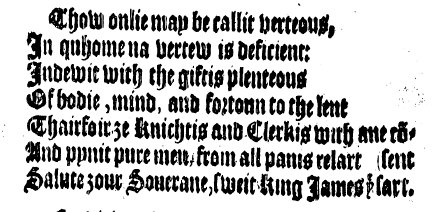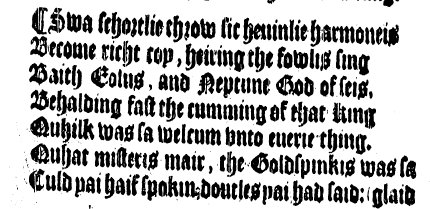| On this Page | Filed elsewhere |
|---|---|
Source: notes file
Date: 12 Jun 2004
File name: S22177
Keywords: Anglo-Saxon
PFS: Anglo-Saxon type, mistranscribed. "Ealoonoom" should be "Ealdordom" and "Ealoonmen" should be "Ealdormen". Looking through, I see that AS type has been inconsistently captured: sometimes mistranscribed, sometimes treated as illegible, sometimes GAPped as 'foreign', sometimes all of these mixed together. I've scrolled through most of the 500 pages (and searched through for "saxon" and characteristic combinations) and corrected and/or supplied several dozen bits of Anglo-Saxon. But I'm sure some miscaptured or uncaptured bits remain.
(The type is not very hard to read, and only differs in a few letters from the ordinary latin alphabet (especially d, s, f, r, and the distinctive characters thorn (captured as þ), eth (ð), and wynn (w), as well as the 7-shaped ampersand (&) and occasionally the crossed-thorn symbol for "that" (&that;). See http://www.lib.umich.edu/tcp/docs/dox/asax.html )
Source: notes file
Date: 13 May 2004
File name: S25067
Keywords: Anglo-Saxon
There were five <GAP foreign>s in this text. One was Gk, three I think in a Gaelic font, and one, I think, in Saxon. I've keyed the Saxon one, as "Hundre$", (p107, im250):
"Cantred is a Brittish word, answering to the Saxon Hundred."
Would you mind checking this and the three that I think are Gaelic? I suppose we do treat Gaelic fonts as non-Roman?
PFS: Theoretically at least, Irish is written in a Roman alphabet; it's just that Irish type design has favored the pointier varieties of late medieval manuscript hands derived originally from the much earlier common insular (Anglo-Irish) book hands. So it is hard to read, especially if one doesn't read Irish to start with; a bit like reading German in fraktur, if one knows no German.
We've had so little Irish that it's not been an issue, but I think our ambition (as with the Anglo-Saxon type) is to capture it if we can. Some printers (including this one?) may well have used the same type for Irish as for Anglo-Saxon.
Source: notes file
Date: 14 Dec 2004
File name: S22172-3
Keywords: Anglo-Saxon, character
A couple of bits of Saxon type were captured as GAP Foreign. I've captured these and looked for others captured as GAPs. Paul, would you mind checking my transcription; I find it hard in particular to distinguish p and wyn.
PFS: I think sometimes the printers were not very concerned to distinguish them either. (and much of the AS type we've seen has been riddled with typos that are much less obviously justifiable, especially if it is in a book that is otherwise in modern English. It is clear that when the printers were unaccustomed to the type, they were prone to set it badly. Makes one wonder how accurate the occasional bits in even more exotic typefaces are (syriac, ethiopic, persian, etc.)
Reviewer: image 227, lh page, I've captured: "sciregemot", "Godes right" and "&wyn;uruldes right"
PFS: these look ok, but looking around, I see *a lot* more Saxon type in here, as one might expect from one of John Selden's books, including extended passages amounting to perhaps two pages or more in total. See, e.g., images 127, 130, 132, 128, 147, and (smaller bits) 122-4, 152, 157, etc. I've typed in all I found (probably inaccurately!). For extensive examples, see http://www.lib.umich.edu/tcp/docs/dox/asax.html
Source: email
Date: 20 August 2002
Vid: 12667
Page ref: 4
Keywords: symbol, scottish
z/yogh

Though our general rule is to leave letters as printed even when the printed letter is a merger of two historically distinct letters (thus we print "ye" for both historic "ye" and historic "þe", since both came to be printed "ye"), we have made something of an exception with regard to yoghs in Scottish books --"something" of an exception because I am not sure that it is really an exception, since one can often make out a real physical distinction between the letter used for zed and the letter used for yogh.
In this short book, I can't find any 'real' cases of zed to compare, but I'd go ahead anyway and change the zeds to yoghs. These are all I find, on a quick survey:
zit
zour
zour
zour
zour
zour
zour
Zour
Zour
Zit
feinze
ze
zour
fenzeit
Zow
ze
vailzeand
Zi$
We have different character entities for upper- and lower-case yogh, namely &YOGH; and &yogh; respectively. So you should change z to &yogh; and Z to &YOGH;.
The p-like thorns.

I don't think you really have any "p"s for thorns. I think all the historic thorns have been printed, as they usually are, as "y." It's just that the "y" in this book is very similar to "p." I can't find any trace of an attempt to distinguish between historic "y" and historic "thorn" so we should leave them all as "y" as we usually do.
The line on the image above I read as follows:
<L>Culd yai haif spokin, doutles yai had said:</L>
The first letter of the first "yai" is clearly "y"; the first letter of the second "yai" is more doubtful: it *may* be a genuine typo (p for y), but it has the crook in the bottom of the ascender characteristic of "y", so as a dubious case I'd make it "y" (a malformed "y") since that what it should be anyway. If it really were a clear "p" I think I'd leave it as "p" in keeping with our rule not to correct printers' errors.
Source: notes file
Date: 6 May 2003
File name: S19525
Keywords: Scottish, yogh, abbreviation
Text showed the usual Scottish preservation of the 'yogh' character (printed as 'z'). pdcc captured these "yoghs" as "z"s. Changed to &yogh; &YOGH; as needed.
Many words (about 800) ended with characters that looked like long "s" and "yogh/z", which pdcc captured, understandably, as the character entity "absed". However, this did not make sense.
PFS: I believe that the characters are an unligatured form of tall-s + z (eszed), which in this text, as elsewhere in Middle Scots, seem to be a spelling of the sound otherwise represented by simple "s". I suggest that we leave them as they appear--i.e. capture them as "sz". So overall in this book, [z] -> &yogh; and [sz] (captured as &absed;) -> sz